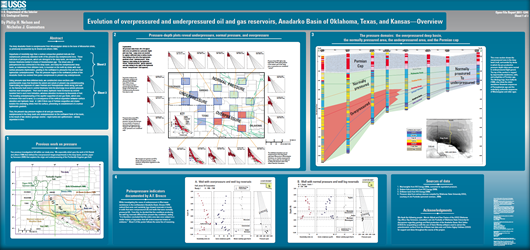Open-File Report 2011–1245
AbstractDepartures of resistivity logs from a normal compaction gradient indicate that overpressure previously extended north of the present-day overpressured zone. These indicators of paleopressure, which are strongest in the deep basin, are mapped to the Kansas-Oklahoma border in shales of Desmoinesian age. The broad area of paleopressure has contracted to the deep basin, and today the overpressured deep basin, as determined from drillstem tests, is bounded on the north by strata with near normal pressures (hydrostatic), grading to the northwest to pressures that are less than hydrostatic (underpressured). Thus the pressure regime in the northwest portion of the Anadarko Basin has evolved from paleo-overpressure to present-day underpressure. Using pressure data from drillstem tests, we constructed cross sections and potentiometric maps that illustrate the extent and nature of present-day underpressuring. Downcutting and exposure of Lower Permian and Pennsylvanian strata along, and east of, the Nemaha fault zone in central Oklahoma form the discharge locus where pressure reaches near atmospheric. From east to west, hydraulic head increases by several hundred feet in each rock formation, whereas elevation increases by thousands of feet. The resulting underpressuring of the aquifer-supported oil and gas fields, which also increases from east to west, is a consequence of the vertical separation between surface elevation and hydraulic head. A 1,000-ft thick cap of Permian evaporites and shales isolates the underlying strata from the surface, preventing re-establishment of a normal hydrostatic gradient. Thus, the present-day pressure regime of oil and gas reservoirs, overpressured in the deep basin and underpressured on the northwest flank of the basin, is the result of two distinct geologic events—rapid burial and uplift/erosion—widely separated in time. 
|
First posted September 29, 2011
For additional information contact: This report is presented in Portable Document Format (PDF); the latest version of Adobe Reader or similar software is required to view it. Download the latest version of Adobe Reader, free of charge. |
Nelson, P.H., and Gianoutsos, N.J., 2011, Evolution of overpressured and underpressured oil and gas reservoirs, Anadarko Basin of Oklahoma, Texas, and Kansas: U.S. Geological Survey Open File Report 2011–1245, 3 sheets, https://pubs.usgs.gov/of/2011/1245
Abstract
Previous work on pressure
Pressure-depth plots reveal underpressure, normal pressure, and overpressure
The pressure domains: the overpressured deep basin, the normally pressured area, the underpressured area, and the Permian cap
Overpressure developed during Pennsylvanian and Permian time
Resistivity logs as paleopressure indicators
Resistivity logs arranged by map location
Top of paleopressure climbs in elevation and cuts stratigraphy from south to north
Top of paleopressure in formations of various age
Shrinkage of paleopressured areas to present-day overpressured areas
Underpressure developed recently
What’s wrong with pressure?
To reveal the control on underpressure, we convert pressure to hydraulic head
The separation between surface elevation and potentiometric surface decreases from west to east in Desmoinesian transects
Potentiometric surfaces
The Nemaha fault zone and outcrops of Upper Pennsylvanian strata establish the pressure reference
Why is the Panhandle-Hugoton gas field underpressured? (Sorenson revisited)
Summary
References